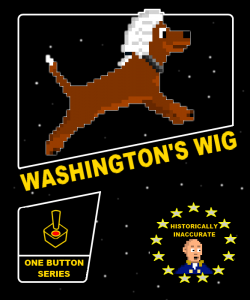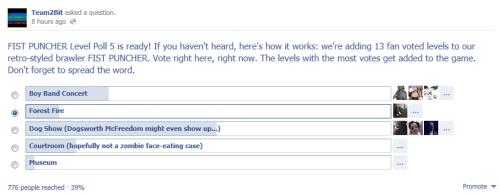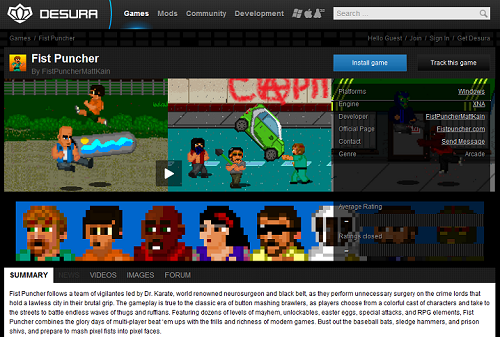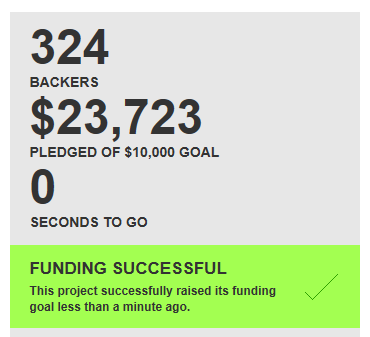Washington’s Wig, the grand prize winning game from season one of IGN’s The Next Game Boss reality show, is now available for Xbox in the Indie Games marketplace. Play as George Washington’s loyal canine, Dogsworth McFreedom, as he tries to return his master’s lost wig in this factually disputed account of one the most audacious surprise attacks in military history. Washington’s Wig contains multiple play modes including an endless runner mode, a level-based arcade mode, a time trial mode, and a 2-player simultaneous race mode. Featuring English dogs in canoes, a patriotic sturgeon, bass thumping hot beats, and crossover characters from two of this summer’s hottest indie games, Escape Goat and A Virus Named TOM, Washington’s Wig is a joyous return to the simplicity and challenge of old-school gameplay. Washington’s Wig is available in the Xbox Marketplace for 80 Microsoft Points ($1). Check out the official Xbox trailer below:
Monthly Archives: June 2012
Fist Puncher Level Poll #5
Fist Puncher level poll #5 is now up on Facebook. As per our stretch goals during our Kickstarter campaign, we’re letting the fans nominate and vote on 13 new levels that will be added to Fist Puncher. We’ve had 4 polls so far, but there’s still time to get in on the action and help decide what levels get added. Just skip over to Facebook and vote.
Fist Puncher on Desura
We’re in the early stages of setting up Fist Puncher for distribution on Desura. Right now it’s in a private, beta release only, but be sure to hop over to Desura and follow Fist Puncher so that you’re 100% ready for its face-smashing release later this year.
Fist Puncher Dream Build Play trailer
We submitted Fist Puncher to Microsoft’s Dream.Build.Play 2012 Challenge earlier today. As many know, we’re hard at work on Fist Puncher preparing it for release later this year. For anyone that’s curious as to how the game is progressing, check out the new Dream.Build.Play trailer that we put up this morning. You can also roll over to the Dream.Build.Play website and take a look at the Fist Puncher submission page.
Fist Puncher Kickstarter Post-Mortem
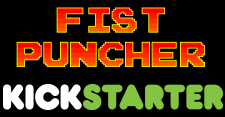
Our Fist Puncher Kickstarter campaign wrapped up a little over a month ago. We aimed for a modest goal of $10K, and in the end fortune smiled upon us. We raised a tad over $23K. To say the least, our campaign was a grueling, marketing-intensive, month-long endeavor where we devoted a majority of our company time and resources to promoting and nurturing our Kickstarter fundraiser. We’re not sure if we’ll ever do another Kickstarter, but we certainly learned plenty about the process.
****************************************
WHAT WENT RIGHT
****************************************
1. Setting Up Our Campaign
The first thing we decided upon was how much money to ask for. We tried to aim low and settle on a figure that was modest, but one that would actually help us survive the upcoming months of game development. With one of our team quitting his day job, our plan was to use our KS funding as a surrogate salary. The more money we could raise, the longer we could survive as game developers before having to return to the salt mines. Realistically, $10K doesn’t go far (especially in Bay Area California). However, as un-established developers, we felt it was a fair amount to ask for. We also made sure to set a few very high incentive levels ($1K, $5K, $10K) in hopes of pulling in the elusive videogame philanthropist. This plan worked (in fact, we had more interest in the high incentive levels than we thought we would), and we were able to snag some very generous donors.
2. Pitch Video
Our pitch video was probably one of the strongest parts of our campaign. We tried to pour as much personality and humor into our video while maintaining a clear, concise description of our project (and making sure to have a requisite hot tub scene). Let’s face it, the pitch video is the meat and potatoes of a KS campaign. It’s the first thing people see when they click on your KS link, and in many cases the introductory 30 seconds of your pitch might be all someone watches before deciding they’d rather check out cat videos on Yahoo news. In other words, the pitch alone can make or break a campaign. Before shooting our video, we spent a fair amount of time watching other people’s pitch videos and trying to learn from what they did right and what they did wrong. It certainly helped that we storyboarded out our video and weren’t afraid to toss out segments that came out dry or tonally inconsistent. In the end, presenting an honest, fun portrayal of our development team and game vision was probably one of the keys to our success.
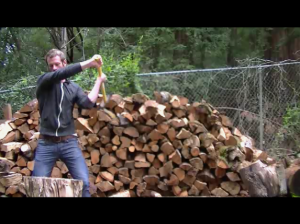
3. Timing
We struck while the iron was hot – no doubt about it. We certainly benefitted from our lingering visibility from winning IGN’s The Next Game Boss and from showing Fist Puncher at GDC. It also didn’t hurt that we snuck in shortly after the Double Fine campaign – Kickstarter was generating buzz all across the worlds of print and digital media. Our campaign also overlapped with PAX East, and we were able to get space at the Kickstarter Arcade and appear as the Project of the Day during the PAX East show. Still, choosing the right time is very, very hard to predict. While we definitely had a strategy related to our Game Boss success, the overlap with PAX East was nothing more than a stroke of luck.
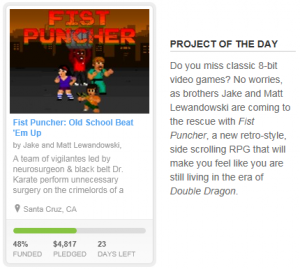
4. What We Showed
We’re not Double Fine. We knew that un-established developers such as ourselves would not succeed with a concept alone. As they say, the proof is in the pudding, and we presented tangible evidence that Fist Puncher was not only a rad idea, but a game that was already roughly 75-80% complete. Having something playable and fully demoable goes a long way in convincing potential backers that you’re not some fly-by-night operation.

5. Promotion
We planned an ambitious promotional assault involving press releases, podcasts, interviews, contests, YouTube videos, Facebook updates, tweets, and blog posts. The bulk of our promotion came through frequent YouTube videos (our original plan was 5 new videos a week). Our relentless marketing campaign helped build momentum in the early days and pull us through the brutal middle section when many campaigns are forgotten or ignored. We also made certain to do periodic, relevant updates on Kickstarter while making sure not to spam our backers with swarms of constant, confusing updates (which we’ve seen many campaigns do).
6. Communication With Backers
We made sure to respond quickly and frequently to any backers or potential backers. We also made update videos giving personal thank-yous and shout-outs to each backer throughout our campaign. We ended up having many backers who raised their pledges after receiving a thank-you or engaging in a pleasant exchange. A little gregariousness and politeness can go a long way.
****************************************
WHAT WENT WRONG
****************************************
1. The Brutal Middle
Our momentum slowed to a near halt during the middle couple weeks of our campaign. Although we had a clear marketing campaign that was intended to last the entirety of our KS run, we lost steam quickly after the first week. Our marketing campaign did enough to prevent us from hitting a complete brick wall, but we certainly could have done much, much better during the middle. At some point we realized that many of our updates were simply going to people who were already Fist Puncher backers and that we were not reaching a new audience. Definitely a problem when you’re trying to keep the ball rolling.
2. No In At The Big Sites
We did our entire campaign without any recognition from Joystiq, Kotaku, Rock, Paper, Shotgun, or any of the big gaming sites. We’re also not active members of communities like Reddit or NeoGAF. It would have helped immensely if we could have secured an interview, a quick write-up, or a thread on one of these sites, but we jumped into our campaign without laying the proper groundwork with any of them. With hundreds of KS videogame campaigns active at any given moment, we should have been more proactive (maybe even aggressive) in trying to get coverage from some of the bigger sites. You simply cannot expect the big guns to come knocking on your door because you’re trying to raise dough for a Peanut Butter Panic sequel or a Corrupt Cop Dating Simulation game.
3. Lack of Cross-Promotion
We were never able to figure out a cross-promotional plan with potential fans outside of the videogame world. Who exactly those fans might be is still a mystery (anti-bullying via Kid Justice? MMA through Dr. Karate?), but it’s certainly something that all potential KS videogame campaigns should consider: find a way to reach non-gamers who might be interested in your project.
4. Biting Off A Little More Than We Can Chew
Our marketing plan involved video updates 5 days a week. This proved to be an exhausting process that after the first week was doing little to bring in new backers. Slimming down and diversifying our promotional plan might have saved us some time and energy while reaching a larger audience of potential backers.
****************************************
****************************************
To be honest, we really didn’t know what to expect when we launched. Would we raise hundreds or hundreds of thousands of dollars? It turned out to be somewhere in the middle, and in the end our KS campaign was a success. We’re now back where we belong spending long days and nights developing games. Still, some of the basic lessons that we learned from Kickstarter should help us in the future when promoting and marketing our studio (or when we launch the Corrupt Cop Dating Simulator Kickstarter).

